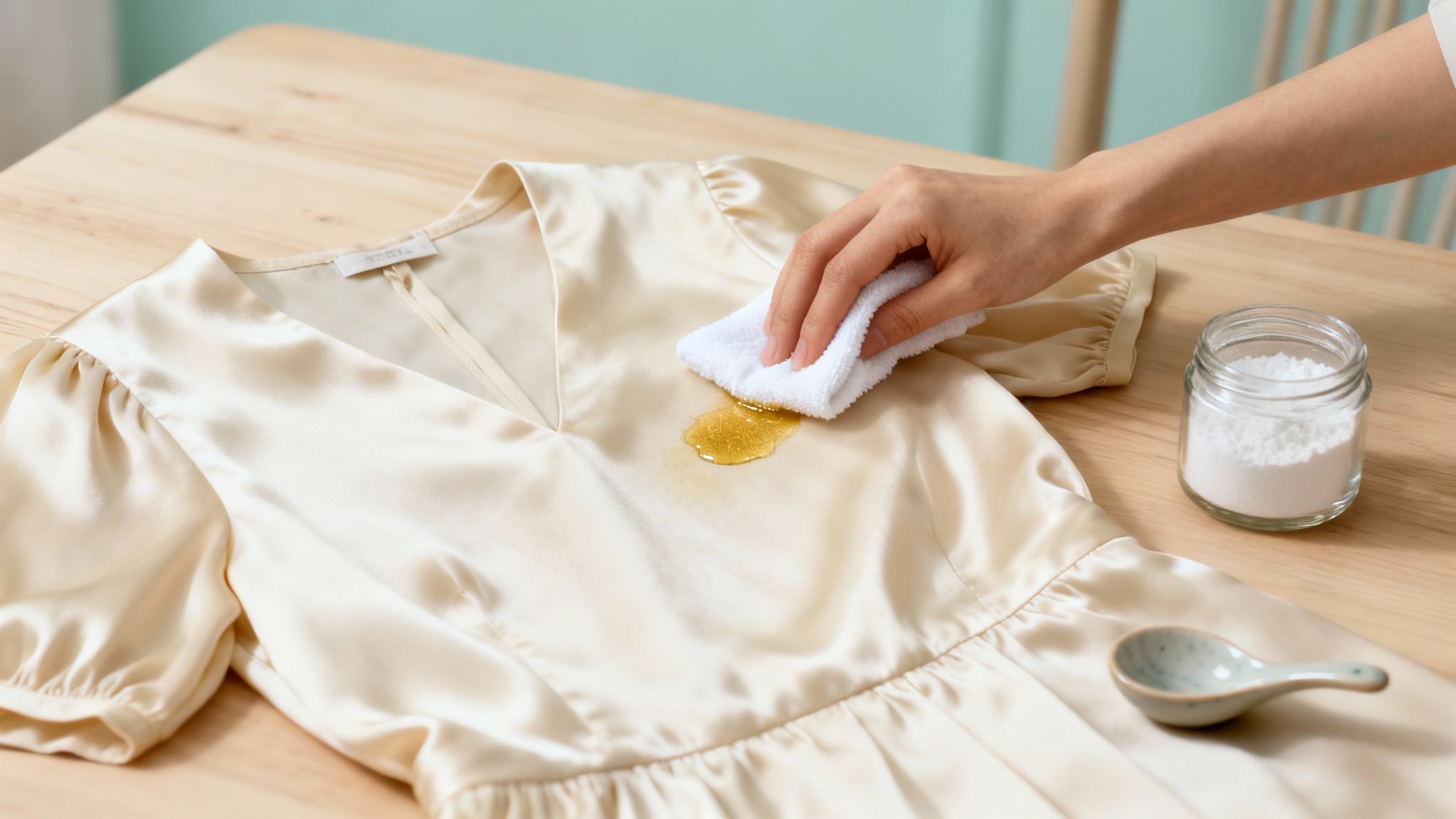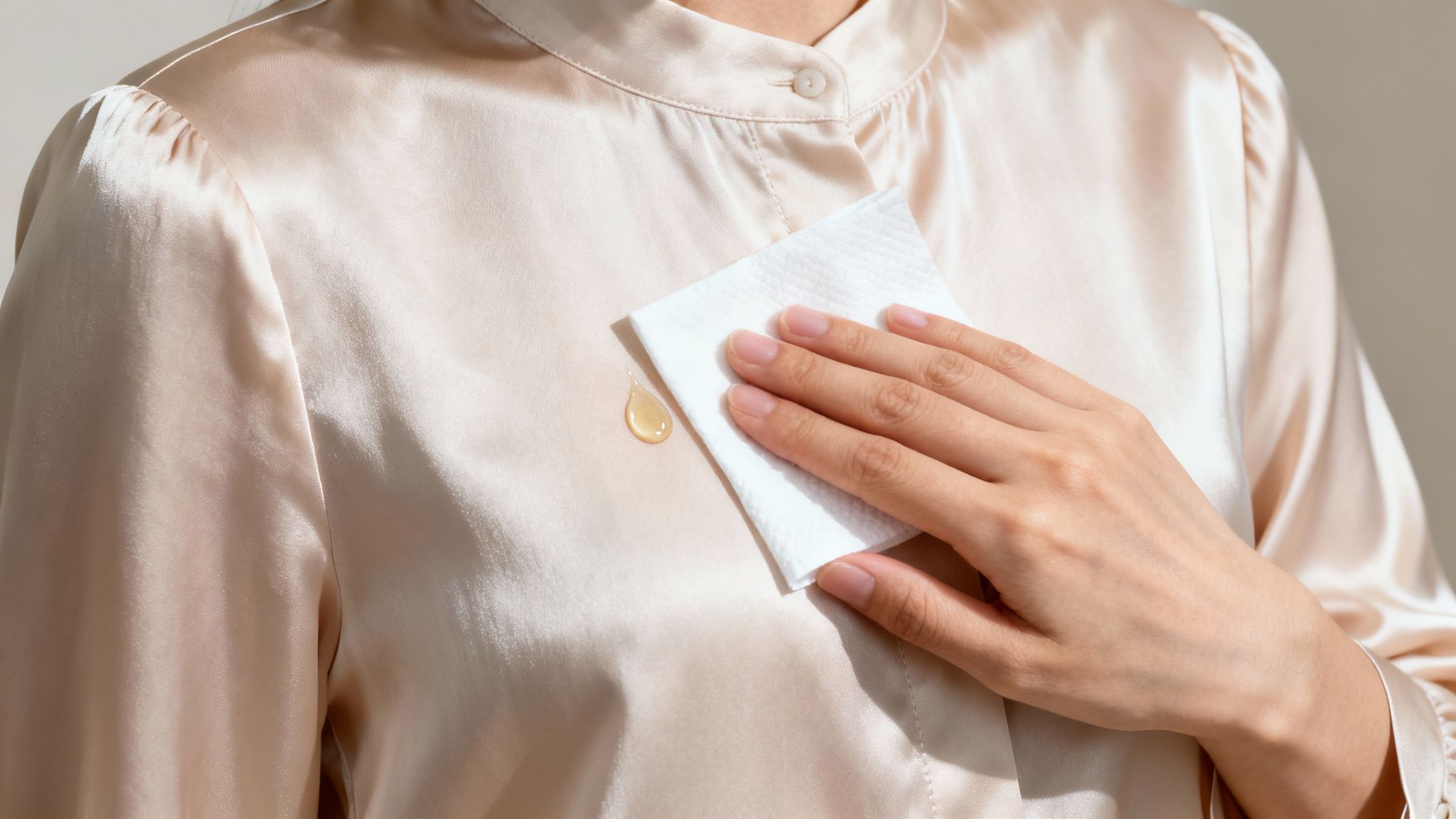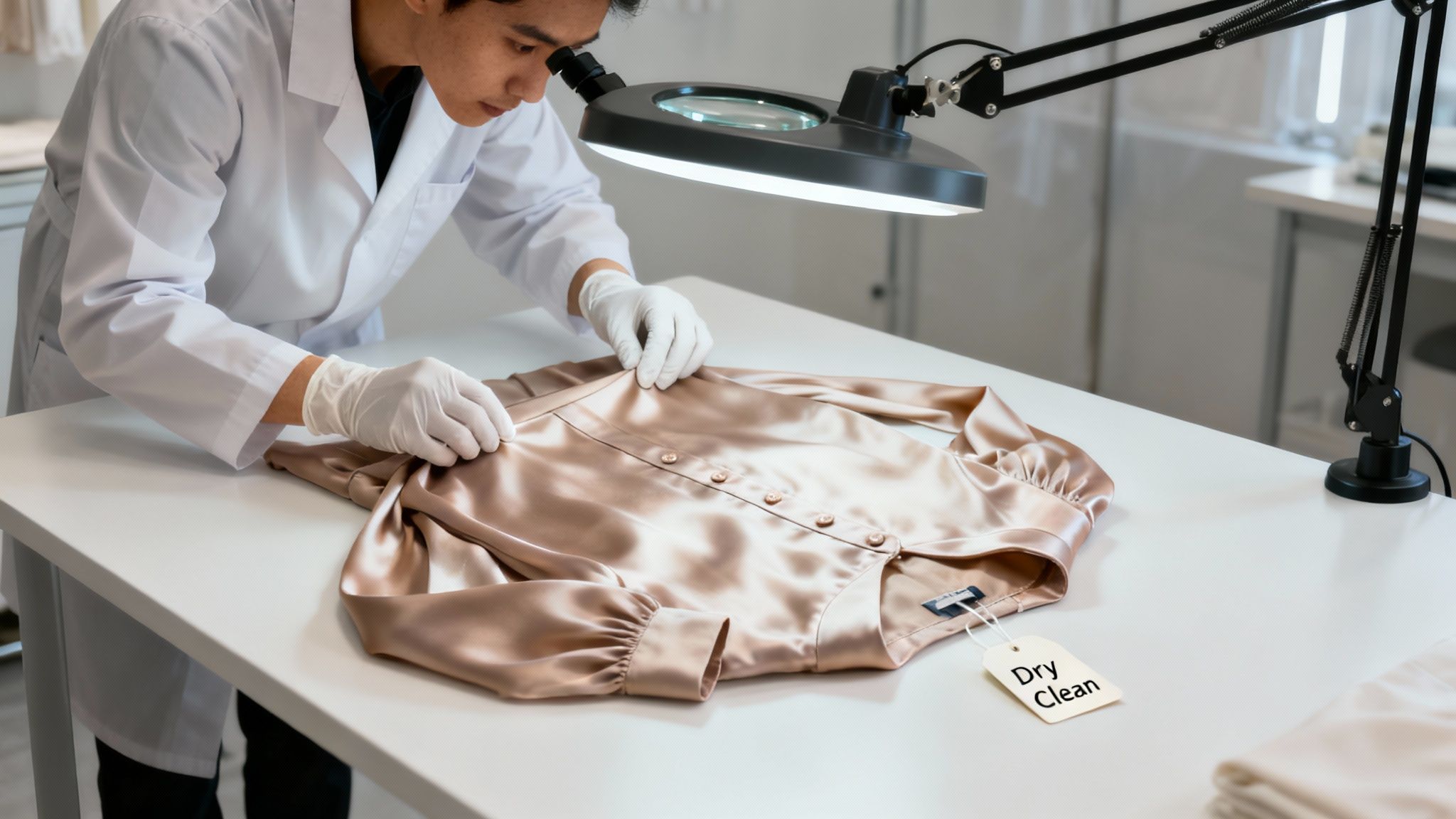how to get oil stain out of silk: quick guide

That awful, slow-motion moment when a rogue drop of olive oil or a smear of lotion lands on your favorite silk scarf? We've all been there. It feels like a tiny catastrophe, but what you do in the next five minutes can make all the difference.
The secret to saving your silk from an oil stain is acting fast. First, blot the stain with a clean cloth to soak up any excess oil, then generously cover it with an absorbent powder like cornstarch. Let it sit for at least an hour before gently brushing it all away. This quick thinking is your best defense against the oil settling into those delicate fibers for good.
What to Do in the First Five Minutes

Unlike sturdy cotton, silk is a protein fiber, which means it absorbs oils and liquids incredibly quickly. That makes it prone to permanent stains if you wait too long.
Oil is a particular challenge because it spreads and seeps into the silk, and harsh scrubbing is out of the question. The fibers are just too delicate and can be easily damaged. Your speed is your best tool here; treating the stain before it has a chance to set is the most effective strategy you have.
Act Quickly and Gently
There's one golden rule when it comes to silk stains: do not rub. Rubbing is the enemy. It grinds the oil deeper into the weave and can fray the threads, ruining the fabric's signature sheen forever. The goal is to lift the oil off the surface, not push it further in.
To give you a quick reference, here's what your immediate game plan should look like.
By following these simple steps, you contain the damage and set yourself up for a successful removal.
Prepare the Stain for Treatment
After you’ve blotted away the surface oil, you’ve basically performed triage. This first step isn't about completely removing the stain—it's about damage control.
By lifting that initial layer of oil, you've prepared the fabric for a more targeted treatment, like an absorbent powder, which can then get to work pulling out the remaining residue. This immediate action drastically improves your odds of restoring your silk piece to its original, flawless state.
If you want to learn more about how to handle other types of spills, check out our pocket guide to vanishing different spots on clothes.
Using Absorbent Powders to Lift the Oil

Once you’ve blotted the fresh spill, your next move is probably waiting in your kitchen pantry. Before you even think about liquid solutions, an absorbent powder like cornstarch, talcum powder, or even baking soda is your safest and most effective first line of defense. There's a reason textile experts swear by this method; it’s a gentle, non-invasive way to tackle the problem.
These fine powders work through a process called adsorption. Essentially, the oil molecules are drawn out of the delicate silk fibers and stick to the surface of the powder particles. Think of it as using a million tiny, powerful magnets to pull the grease away from the fabric without causing any harm. For a material as delicate as silk, this is a huge win, since aggressive treatments can easily cause permanent damage.
How to Apply the Powder Correctly
Your technique here really matters. Don't be shy with the powder—you want to build a thick, generous layer that completely covers the entire stained area. A light dusting just won't have the absorbent power to lift the oil out. You should have a small mound covering the spot.
Once it's on, the most important ingredient is patience. The powder needs time to do its job.
Key Insight: Let the powder sit on the stain for at least an hour. For bigger or older spills, leaving it overnight can make a world of difference. This extra time gives the powder the best possible chance to draw out all the oil that has seeped into the silk’s protein fibers.
This gentle, patient approach is often all you need to fix the stain, saving you from having to try more intense cleaning methods.
Removing the Powder and Checking Your Work
After letting it sit, it's time to get the powder off. Grab a soft-bristled brush, like a clean makeup brush or an old toothbrush, and gently sweep the powder away. The key is to be gentle; you want to brush the powder off the surface, not grind it back into the fabric. Once most of it is gone, you can give the garment a light shake to dislodge any leftover residue.
Now, take a good look at the area in bright light. You might find the stain is completely gone. If a faint mark is still there, don’t panic. This is pretty common, and you can just repeat the whole process with a fresh pile of powder. A second or even third round can often knock out any lingering oil. The best part is that this method is safe enough to repeat without risking damage to your silk.
For a deeper dive into stain removal principles that apply to more than just silk, you can read more about how to remove oil stains from various fabrics in our detailed guide.
Spot Treating Stains with a Gentle Detergent

Sometimes, even after you’ve diligently used powder, a faint, shadowy mark remains. This is totally normal. It just means the oil has worked its way a little deeper into the silk’s delicate protein fibers. When that happens, it’s time to call in a bit of reinforcement: a direct, but still incredibly gentle, cleaning agent.
This is where you bring in a mild detergent to break down what’s left of the oil. It's also the step where many people make costly mistakes. Reaching for your regular laundry detergent or dish soap is a recipe for disaster. Those products are loaded with harsh degreasers and enzymes that are far too aggressive for silk, risking color loss, weakened fibers, or a dull, lifeless patch.
Choosing the Right Cleaning Agent
Your success here really hinges on picking the right tool for the job. You need a cleaner that dissolves oil without attacking the fabric itself.
Look for a detergent that is:
- pH-Neutral: Silk is a protein fiber, a lot like your own hair. Anything too alkaline or acidic will make it brittle. A pH-neutral formula is a must to keep it strong.
- Made for Delicates: Products specifically labeled for "delicates," "wool," or "silk" are your best friends. They’re designed to be gentle and rinse away cleanly.
- Free of Dyes and Enzymes: Steer clear of colorful detergents or those bragging about "stain-fighting enzymes." Those enzymes can actually start to digest the silk protein.
A clear, gentle liquid soap is always the safest bet. Taking a moment to select the right one is the most important part of getting an oil stain out of silk without causing more damage.
Pro Tip: Whatever you do, don't apply detergent directly to dry silk. Always, always dilute a tiny drop in a small bowl of cool water first. This creates a gentle solution that won't shock the fabric or create a concentrated new spot.
The Spot-Treating Technique
Once you have your diluted solution, the process becomes about patience and precision. Remember, you're spot-treating, not washing the whole garment. Dunking the entire piece can lead to dreaded water rings, especially if your tap water has a high mineral content.
First, do a quick patch test on a hidden area, like an inner seam, just to be sure it doesn’t mess with the color. All clear? Great. Now, dip a clean, white cloth or a cotton swab into your solution.
Gently dab—never, ever rub—the stained area. Start from the outside edges and work your way in. This simple trick keeps the stain from spreading. You should start to see the detergent solution working its magic, breaking down the remaining oil.
For a really stubborn spot, you might need a second go. If the stain is still there after the first try, you can find mild detergents made specifically for silk. These are usually pH-neutral and acid-free and can be reapplied before rinsing with cool water to avoid any heat damage. You can find more detailed tips on this advanced technique over on SlipIntoSoft.com.
To finish, rinse the area by dabbing it with a different cloth that's just dampened with cool water. Blot it dry with a clean towel and let it air dry completely, far away from direct heat or sunlight.
When You Should Call a Professional Dry Cleaner

While the at-home methods we've covered can be lifesavers for small, fresh oil spills, there's a point where the smartest move is to step back and let an expert take the wheel. Knowing when to call it quits is just as crucial as knowing how to treat a stain in the first place. Pushing a DIY solution too far can turn a fixable spot into a permanent blemish.
Sometimes, the stain itself makes the decision for you. If you’re dealing with a huge spill that has soaked a large part of the fabric, spot-treating it at home is a recipe for water rings and an uneven finish. The same is true for the type of oil—a light vinaigrette is one thing, but heavy-duty culprits like motor oil or certain thick cosmetics need a professional’s touch.
Recognizing When You’re Out of Your League
There are some clear signs that a stain is beyond the reach of household remedies. If you've tried the powder and gentle detergent method a couple of times with zero progress, it's time to call for backup. Continuing to work on the area can start to break down the delicate silk fibers, causing damage you can't undo.
Think of these scenarios as automatic red flags:
- The stain is old and set-in: An oil stain that’s been sitting for more than 24-48 hours has had time to oxidize and bond with the silk's protein fibers. This makes it incredibly difficult to lift without specialized solvents.
- The oil comes from a synthetic source: Stains from things like bike grease, car oil, or heavy machinery lubricants are too complex for gentle, home-friendly detergents to break down effectively.
- The garment is irreplaceable: For that cherished vintage blouse, an expensive tie, or a sentimental scarf, the risk of a DIY mistake just isn't worth it.
Key Takeaway: Professionals have access to powerful, controlled solvents designed to dissolve stubborn oils without harming the delicate structure of silk. It’s a level of precision that’s nearly impossible to replicate safely in your laundry room.
DIY vs. Professional Cleaning: A Decision Guide
Deciding whether to tackle a stain yourself or head to the pros can be tough. This little guide should help you make the right call based on the stain you're facing.
Ultimately, if you have any doubt, choosing the professional route is always the safer bet for a garment you truly care about.
The Real Value of Professional Expertise
Trusting a professional isn't giving up; it’s making a smart, strategic choice to save your garment. You're not alone in this—industry data shows that over 65% of consumers with silk clothing use professional dry-cleaning services at least once a year to handle tricky stains and maintain quality.
When you bring us your silk piece, you’re not just paying for a machine. You're paying for years of experience. A professional cleaner can identify the specific type of oil and select the perfect solvent and technique to remove it without a trace.
To see how we handle these delicate jobs with care, you can learn more about our specialized dry cleaning services for silk and how we work to protect your favorite pieces.
Troubleshooting Common Removal Problems
Even when you do everything right, getting an oil stain out of silk can sometimes feel like a two-steps-forward, one-step-back dance. You manage to lift the greasy mark, only to find a new, fainter problem has taken its place. Don't panic. This is a normal part of the process, and with a little more patience, you can usually get it sorted.
The most common culprit is the dreaded water ring—that faint, shadowy outline that appears after you’ve spot-treated the fabric. It happens when minerals from your tap water get left behind as the area dries, creating a frustrating, but fixable, watermark.
The Problem of Water Rings
So, the oil is gone, but now you have a faint ring that can be just as noticeable. What do you do?
You have a couple of solid options. One is to gently steam the area with a handheld steamer. If you don't have one, just hanging the garment in the bathroom during a hot shower can work wonders. The key is to let the steam relax the fibers without getting the silk soaking wet.
Another great trick is to use distilled water, which is mineral-free. Lightly dampen a clean, white cloth with it and gently blot the edges of the water ring. You want to feather the moisture outward, blending the transition so it dries without a harsh line.
When the Fabric Feels Different
Have you ever treated a spot only to find the silk feels a little stiff or has lost its beautiful sheen in that one area? That’s almost always a sign of a tiny bit of leftover detergent residue clinging to the fibers. It just means the rinsing step wasn't quite as thorough as it needed to be.
The fix is simple: just re-rinse the spot. Dampen a fresh, clean cloth with cool water and gently blot the area until you’re sure all the soap is gone. Let it air dry completely. And whatever you do, never use heat to speed things up. Heat can set that residue, making the stiffness permanent.
Expert Insight: The secret to getting stains out of silk is gentle repetition, not brute force. Scrubbing harder won't work—it will only break down the delicate protein fibers and make the problem worse. Be prepared to repeat your chosen gentle method several times to see results.
This isn't just experience talking; it's backed by textile science. Conservation institutes often note that completely removing a stain can take five to seven gentle reapplications of a treatment. This is why so many silk care guides warn against aggressive DIY methods. Slow, patient, and gentle always wins.
If a few patient attempts aren't making a dent, that's your cue to stop and call in a professional. You can learn more about reviving silk by exploring the detailed cleaning insights on CleanAvenueNYC.com.
A Few More Questions About Silk Care
Even with the best guide, sometimes you just have a specific question. Here are some of the most common things people ask when dealing with oil on their silk, answered simply and directly.
Can I Use Dish Soap on a Silk Stain?
It’s a tempting idea, but honestly, it's a risky move. We generally tell people to steer clear.
While a very mild, clear, pH-neutral dish soap might work in a pinch, most of them are packed with harsh degreasers, dyes, and fragrances. These ingredients are great for pots and pans but terrible for silk—they can strip the color, damage the delicate protein fibers, and leave a permanent mark that's worse than the original stain.
It's always safer to grab a detergent made specifically for delicates. If you're in a real bind and have no other choice, test a tiny, highly diluted amount on a hidden seam first to see what happens.
How Do I Remove an Old, Set-In Oil Stain?
This is where things get tricky. Old oil stains are a much bigger challenge because the oil has had time to oxidize, which means it has chemically bonded with the silk fibers. You can certainly try the absorbent powder and gentle detergent methods we've covered, but your chances of getting it out completely at home are much, much lower.
For those old, stubborn stains, your best and safest bet is to trust a professional dry cleaner. They have access to specialized solvents designed to break down oxidized oils without destroying the fabric.
Here's why it's so different: The real enemy with old stains is oxidation. Once oil oxidizes, it requires a completely different chemical approach to dissolve. That's why professional-grade solvents are often the only solution for older, more stubborn spots.
Will Rubbing Alcohol or Hairspray Work?
Please, no. Using harsh solvents like rubbing alcohol, hairspray, or nail polish remover on silk is a recipe for disaster. These chemicals are far too aggressive for the delicate protein fibers in silk.
They can, and often will:
- Strip the Color: Leaving a bleached, faded spot right where you're trying to clean.
- Dissolve the Sheen: Ruining that beautiful, natural luster that makes silk so special.
- Weaken the Fibers: Making the fabric brittle and possibly even creating a hole.
Trust us, the damage from these "hacks" is almost always more noticeable and permanent than the original oil stain. Stick to gentle, proven methods.
What Is the Best Way to Prevent Oil Stains?
The best way to know how to get an oil stain out of silk is to avoid getting one in the first place. A little mindfulness goes a long way. Be extra careful when you're wearing your favorite silk pieces, especially during meals or while cooking.
A great habit to get into is applying any lotions, makeup, or hair products that contain oils before getting dressed. This simple step can prevent a lot of accidental transfers. Proper storage is also key—keeping your silk items hung or folded away from potential spills will help keep them looking pristine.
Beyond just stains, keeping silk beautiful requires proper overall care. For more tips on general maintenance, this detailed guide on how to wash and care for silk pillowcases has some excellent advice.
When a stain just won't budge or the garment is too precious to risk, don't guess. Columbia Pike Laundry offers expert dry cleaning services designed to handle delicate fabrics like silk with the utmost care. We’ll give your favorite pieces the professional attention they deserve, so you can wear them with confidence. Schedule your pickup today at https://columbiapikelaundry.com.
Popular Blog Articles

Meet the Author
Daniel Logan didn’t start CPL because he loved laundry. He started it because his family was drowning in time debt, and laundry was one of the biggest weights.
Mornings were chaos with two kids under 5. Evenings felt like catch-up. And weekends? Gone to sorting socks and folding piles.
He knew his story wasn’t unique. So he built a business that gave families like his just a little bit of breathing room one load at a time.
With no laundry experience but deep tech skills, Daniel rolled up his sleeves, doing every job himself while building systems that turned it into a modern laundry service that saves customers time, simplifies their lives, and delivers reliability they can count on.
That’s where CPL began. Not from a playbook, but from pain. From one dad trying to buy back time: for himself, and for every household like his.





